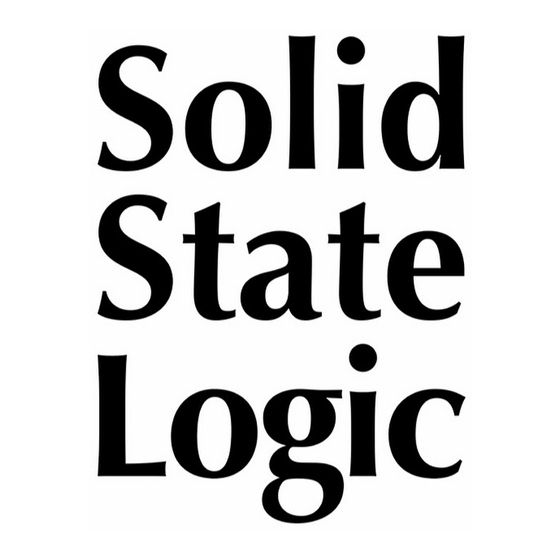
Summary of Contents for Solid State Logic XLogic Super-Analogue
- Page 1 Solid State Logic S U P E R A N A L O G U E C H A N N E L A D C Super-Analogue™ Outboard Owner’s Manual 82S6XL070A...
- Page 2 Solid State Logic, Oxford, England Revision 0A, May 2004 Minor changes, November 2004 Minor changes, June 2005 As research and development is a continual process, Solid State Logic reserves the right to change the features and specifications described herein without notice or obligation E&OE...
-
Page 3: Table Of Contents
Contents Contents 1. Introduction Warranty 2. Safety Considerations Definitions Electrical Safety Warnings Installation 3. Installation Supplied Parts Tools Required Procedure 4. Operation Synchronisation Sample Rates Appendices A. Internal Links B. Connector Details C. Electronic Specification D. Physical Specification E. Environmental Specification Page 1... - Page 4 XLogic Channel ADC Owner’s Manual AES OUT SPDIF OUT SYNC SAMPLE RATE Fs x 1 2 3 4 5 6 SYNC IN RIGHT IN Plan (top) and elevation (lower) of the 629605 Channel ADC card Page 2...
-
Page 5: Introduction
In the event of a fault during the warranty period the unit must be returned to your local distributor who will arrange for it to be shipped to Solid State Logic for repair. All units should be shipped to Solid State Logic in their original packaging. -
Page 6: Safety Considerations
Electrical Safety Warning When installing or servicing any item of Solid State Logic equipment with power applied, when cover panels are removed, HAZARDOUS CONDITIONS CAN EXIST. These hazards include:... - Page 7 Safety Considerations Installation Voltage Selection and Fusing The XLogic Channel ADC card is fitted internally to the XLogic Channel unit and so does not require a mains supply. CE Certification Modifying any of the metalwork of the XLogic Channel unit to which this assembly is fitted in any way may adversely affect the CE certification status of the product.
-
Page 8: Installation
(either loose or plugged into PL5 on the ADC card). • 82S6XL070A - XLogic Channel ADC Installation Guide (this document) Solid State Logic S U P E R A N A L O G U E C H A N N E L A D C Super-Analogue™... -
Page 9: Tools Required
Installation Tools Required Other than any tools which may be required to remove the XLogic Channel unit from any racking or studio furniture, the following tool is all that is required to install this card: Part No. Description Notes 80C2CECC 1-point pozi-drive screwdriver This is not a ‘philips’... -
Page 10: Procedure
XLogic Channel ADC Owner’s Manual Procedure Remove the XLogic Channel unit from any racking or studio furniture, and place it on a suitable clean, flat work surface. Ensure that the work area is adequately illuminated and then proceed as follows: 1. - Page 11 Installation 3. Remove the ADC card from its sealed anti-static bag, either fold back or remove and place to one side the short ribbon cable attached to PL5. Slide the ADC card through the apperture in the rear of the XLogic unit that was revealed in step 2. above. It may be necessary to lift the ‘OUTPUT’ and ‘Gnd’...
- Page 12 XLogic Channel ADC Owner’s Manual 5. Check that the rear plate of the ADC card is flush to the rear panel of the XLogic unit and tighten the six screws; these screws need only be lightly tightened – the ADC card isn’t going to be escaping out of the box by itself…...
-
Page 13: Operation
Operation Operation On the rear panel of the ADC card are four sockets and one multi-position DIP switch. Their functions are as follows: Synchronisation AES/EBU and SPDIF Options Outputs AES OUT SPDIF OUT OUTPUT KEY IN SYNC SAMPLE RATE Fs X 1 2 3 4 5 6 SYNC IN RIGHT IN... -
Page 14: Sample Rates
XLogic Channel ADC Owner’s Manual Sample Rates There are eight possible preset sample rate options ranging between 44.1kHz and 192kHz. The different rates are selected with switches 4 to 6 as follows: Sample Rate Switch(es) Detail 44.1kHz With all three switches ‘off’ (down), this sets the ADC to run at 44.1kHz stereo. - Page 15 AES/EBU (≈1V pk-pk). Conversion from balanced to un-balanced AES/EBU is best achieved with a third-party in-line transformer. These are widely available – your local Solid State Logic distributor should be able to supply these. Alternatively, a standard 110Ω balanced feed can be used, albeit at the expense of increased jitter due to the level/impedance mis-match.
- Page 16 XLogic Channel ADC Owner’s Manual Page 14...
- Page 17 Appendix Appendix A – Internal Links There is one internal link on the ADC card: Sets the operating level as follows: 1-2 +24dBu ≈ 0dB FS (factory default) 2-3 +18dBu ≈ 0dB FS Appendix B – Connector Details Right In Location: Rear Panel Conn' Type:...
- Page 18 Following are audio performance specification figures for the XLogic Channel ADC card, when fitted to an XLogic Channel unit. No other Solid State Logic products, including the XLogic Channel unit with which this card operates, are covered by this document and the performance of other Solid State Logic products can not be inferred from the data contained herein.
- Page 19 Appendix Appendix D – Physical Specification * Depth: 180mm/7.0 inches PCB only 203mm/8.0 inches including rear panel and connectors Height: 36mm/1.4 inches including rear panel Width: 90mm/3.5 inches PCB only 100mm/3.9 inches including rear panel Weight: 150g/5.5 ounces Boxed size: 190mm x 290mm x 70mm (7.5"...
- Page 20 XLogic Channel ADC Owner’s Manual Notes Page 18...




Need help?
Do you have a question about the XLogic Super-Analogue and is the answer not in the manual?
Questions and answers